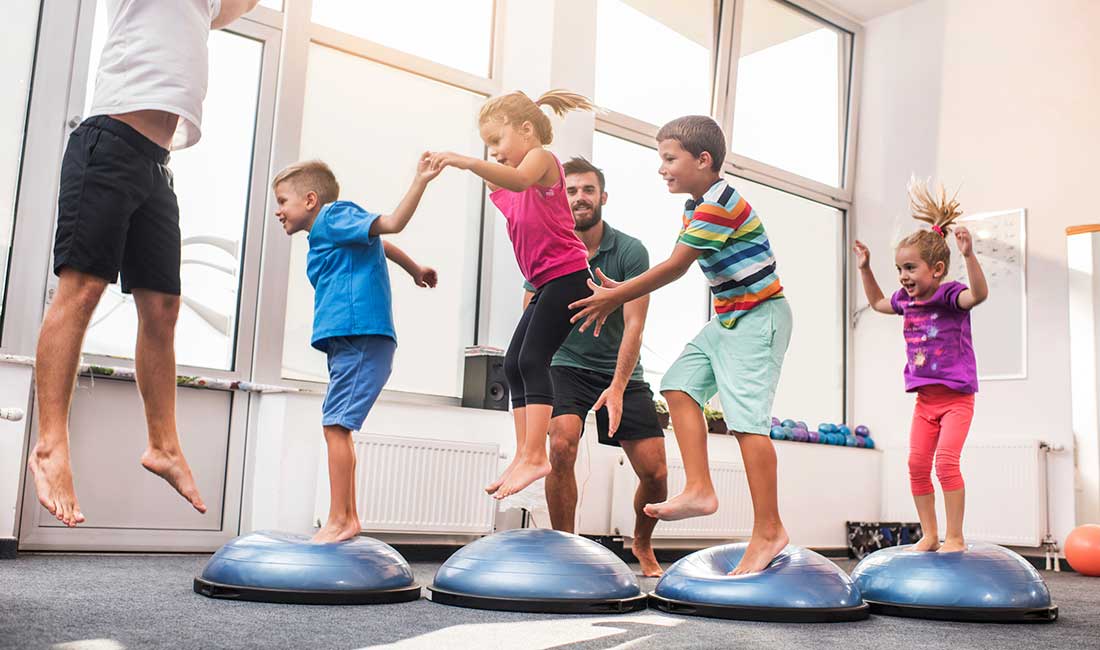Picture you and your friends flying around in laser-powered jet packs through imagination-bending surroundings, acting out your dreams of becoming superheroes. Thanks to video-game technology, you can experience all of this and more in a convincingly realistic way without even leaving your couch.
Every day, millions of children are doing just that.
Various survey-based research has observed children engaging with inactive virtual technology anywhere from three to six hours per day. Although the American Medical Association suggests children get 60 minutes of vigorous physical activity per day, the Centers for Disease Control suggest only about 25% of children meet this goal. Studies have also shown that active kids are smarter kids.
Let’s face it. The immediately accessed gratification, sensory overload and fantastical imagination that virtual technology offers is tough competition for the more physically demanding, delayed gratification of exercise.
Virtual technology is here to stay, so if our goal as teachers, parents and health and fitness mentors is to get kids excited about exercise again, we need to acknowledge the competition and step up our game.
Here are three ways we can start making exercise “cool” again to get kids off the couch and enjoying physical activity as a lifestyle.
1. “Exercise” is Not Merely a Means to an End

Many of us can remember the hours we spent as a kid playing outside, making up games and occasionally attending a sports practice. Our primary motivation? Fun! It was during these frequent fun and imagination-fueled play sessions that we developed the lifelong skills of fitness and physical literacy.
Now the early specialization and high level competition of the youth sports complex has shifted the youth physical-activity paradigm. With a decline in both free-time play and access to physical education, we now rely heavily on youth sports to fill this void of daily physical activity.
To have an opportunity to play on a team, however, children’s free-time now must be focused on improving specific skills associated with a sport.
Gone are the days of pick-up games on a sandlot. Here are the days of private skill coaches for seven-year-olds. Whereas daily play and exercise was once merely an outlet for fun, it is now primarily a means to gain notoriety, prestige and a possible a college scholarship. Exercise is no longer a vacation for children—it’s a vocation.
Kids haven’t resorted to inactive virtual technology because they’re lazy. They’re trying to relax!
It’s important to strive to provide time, participation and even guidance, if necessary, for kids to engage in daily free play. Kids need to move for the sake of moving. This notion has been so lost for so long, we may need to show them how. This might mean showing your kids how to play “500” or soccer-tennis, or maybe it means playing a game of capture the flag or Frisbee after dinner.
Coaching and guidance can develop specific skills, and play can develop the imagination, desire and excitement to participate in any physical activity for a lifetime.
2. Watch Your Language

Active kids come from a “culture of wellness” at home. In other words, if you want your kids to be active, you need to be active. If mom and dad spend most of their time with some form of virtual technology (TV, mobile devices, video games), their children will learn that this is the way to relax as well.
Parents’ attitudes toward exercise are revealed by the ways they speak and act. “Daddy has to go running because I have to lose weight.” “Mommy has to exercise because I ate cookies yesterday.” In a child’s mind, these commonly expressed perceptions of exercise frame it as a form of penance or punishment for sinfully enjoyable pursuits.
Why would kids want to participate in punishment?
As adults, we have to set an example. Our kids should see us utilizing exercise as a way to relax, disconnect and play. Our language regarding exercise should reflect the fact that we choose to move because it makes us feel good. We should make exercise appear as something to be enjoyed and embraced as a lifestyle.
3. The Power of the Imagination

Prior to virtual technology, it was our imagination that allowed us to fight bad guys, build forts and avoid the “lava” surrounding us by jumping from rock to rock. The creative portions of our brains were highly involved in physical activity. This not only made it fun, it opened up a world of possibilities for being physically active.
While children still have active imaginations, early sports specialization and virtual technology have taken the creative process out of exercise. In fear of children having “nothing to do,” many parents commit their children to nearly non-stop guidance with physical activity.
Under this guidance, there’s always a criteria: right or wrong, success or failure, good or bad. While guidance during physical development is essential in creating high level skills, allowing children to discover how to move during imaginative play helps lay a foundation of lifelong fitness and physical literacy.
Because creative, imaginative play is not a part of youth culture as it once was, we may need to help facilitate this with our children. The first step is to be comfortable with the notion of kids “being bored” and not rushing to fill their time. Necessity is the mother of invention.
I can recall professing my boredom to my mother once in my life. After the longest list of chores a 10-year-old had ever seen, I quickly got good at creating activities to fill my time.
Consider using the following creative physical activities and games with your children, and then allowing them to expand and create on their own.
- Sock Fight: With as many balled-up socks as one can carry, the house becomes a sock battle-ground. Children’s socks are small and light and pose little risk of knocking things over. If there is a concern, adults may want to restrict this activity to a specific room in the house, or somewhere outdoors.
- One individual or group gets a 10-count to set up a “base” with the other group or individual closing their eyes.
- After the 10 count, one party goes in search of the base.
- When the two parties make contact, they throw the balled-up socks at one another, both attempting to avoid being hit.
- After three hits, you’re out.
- Lava Land:
Many of us remember jumping from piece of furniture to piece of furniture, rock to rock, or anything else we could stand on without touching the ground.
- Place various implements (that can be stood upon) throughout the house or outdoors.
- Tell kids that the ground is lava, water, fire or some other undesirable substance.
- Have the kids navigate the environment, only stepping on the implements you provided.
- If they fall off of the implements, they must start wherever they originally began.
- The Mission:
Young children often fantasize about enacting the heroic exploits of their favorite video game, book or television characters. To provide a little guidance, create a way to send them on their own imagination-based mission.
- Cut up 20 to 30 pieces of paper.
- On each piece of paper, write a short “challenge” activity; for example, “Crawl under the table three times,” “Run around the house two times,” “Hide a treasure in the backyard and make a map to find it.”
- Put these pieces of paper in a jar.
- Kids can pick five pieces of paper at a time. Their mission is to perform these tasks within a certain period of time.
- Keep the jar somewhere accessible and add to it periodically, sneaking in some chores and other activities.
Remember, the goal with these activities is to stimulate the creative process with children. Any guidance you provide should merely provide them with general inspiration and safety. The hope is that they take this inspiration and begin to create on their own.
While inactive virtual technology continues to grow in popularity, by using these strategies, we can create opportunities for children to once again enjoy being physically active.




 by
by 







 by
by